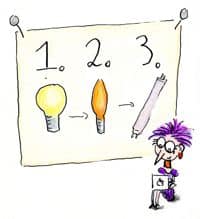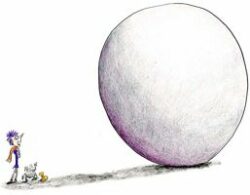Learn how to get your ideas on paper faster
By streamlining the 8 steps in the writing process, you can turn messy thoughts into persuasive writing and you can write faster.
Content of this page
Click the links below to go to a specific section:
3 proven writing strategies
8 steps in the writing process
Streamline your writing process
The copywriting process
Recommended courses
3 proven writing strategies
 Getting your thoughts onto paper becomes easier when you select a writing strategy (or process) that works for you.
Getting your thoughts onto paper becomes easier when you select a writing strategy (or process) that works for you.
This article discusses 3 writing strategies: A carpenter outlines before writing; a freewriter just starts writing; and a knitter edits while writing …
8 steps in the writing process
The steps outlined below are applicable to writing articles, blog posts, or essays. The process for writing sales copy is different (see here).
While the numbered steps below may imply a logical process, the truth is that the writing process is often messy and we may need to go back a step.
Ideas that seem well-formed in our mind, turn out more messy when we commit them to paper. A first draft may throw up issues that we hadn’t foreseen in our outline. In such a case, we need to reconsider our outline and even adjust the purpose of the article. Such an iterative process is normal.
Writing sharpens our thinking.
1. Idea generation
 To brainstorm ideas, imagine who you’re writing for and jot down how you can help. Which aim do you help achieve? Which problem does it help solve? Which question does it answer?
To brainstorm ideas, imagine who you’re writing for and jot down how you can help. Which aim do you help achieve? Which problem does it help solve? Which question does it answer?
A good idea defines the purpose of an article and its audience. For instance: This article helps business writers understand the 8 steps in the writing process so they can write faster.
Keep a record of all your ideas, and pick the ideas that you feel excited to write about and that will help your readers improve their lives.
2. Outline your ideas
 A good outline provides a brief overview of what you’ll cover and in which order. It helps structure your writing so you can write a better first draft, and you can write faster.
A good outline provides a brief overview of what you’ll cover and in which order. It helps structure your writing so you can write a better first draft, and you can write faster.
A clear structure for your blog post will also help your reader grasp your message more easily.
3. Research
 Research will help widen or deepen your knowledge. It enriches the writing experience and helps you write about topics you previously had little knowledge of. You discover new insights, make new connections, and you may even gain new experiences and new wisdom.
Research will help widen or deepen your knowledge. It enriches the writing experience and helps you write about topics you previously had little knowledge of. You discover new insights, make new connections, and you may even gain new experiences and new wisdom.
Interviewing experts can accelerate your research. For me, books are my main source of research.
Learn how reading can fuel your writing …
4. Write a first draft
 The aim of a first draft is to get your thoughts on paper, no matter how roughly.
The aim of a first draft is to get your thoughts on paper, no matter how roughly.
At this stage it doesn’t matter how good or bad your writing is. You can’t revise a blank sheet of paper but you can turn a rough first draft into a shiny piece of content.
5. Revise your writing
 Revising and editing your content goes faster if you do it in several steps. The first step is to check the focus and flow of the content. Is any information redundant? Is anything missing? Is the order logical?
Revising and editing your content goes faster if you do it in several steps. The first step is to check the focus and flow of the content. Is any information redundant? Is anything missing? Is the order logical?
6. Edit your writing
 After you’ve restructured your content and you’re satisfied with the overall flow, it’s time to edit your writing sentence by sentence.
After you’ve restructured your content and you’re satisfied with the overall flow, it’s time to edit your writing sentence by sentence.
You make each sentence concise, vivid, and human. You pay attention to tone and rhythm. You polish your words until your message shines brightly.
7. Proofreading
Proofreading your own text can be hard as we don’t always see our own mistakes. You may want to hire a proofreader or try an app like Grammarly to check for grammar and spelling mistakes. If you proofread your own work, leave your text for at least 24 hours so you can look at it with fresh eyes.
8. Formatting
The last step before publication is to format your text.
Is there enough white space to make reading a pleasurable experience? Can you add images to help explain your ideas more clearly? Does your layout invite a web visitor to start reading—even if they’re in a hurry?

Improve your writing skills
Learn how to write better and faster. Get free writing tips in your inbox.
Streamline your writing process
The writing process can easily be derailed. Self-doubt pop up. Your friend Procrastination pays a visit. Or perfectionism keeps you stuck. How do you keep momentum going?
Deal with perfectionism
 I used to think that perfectionism would only strike when I was hesitant to click Publish.
I used to think that perfectionism would only strike when I was hesitant to click Publish.
But perfectionism can strike us at any stage of the writing process.
We can get stuck in a research phase, afraid that we don’t know enough. We can procrastinate and delay writing a first draft because we want to write the perfect first sentence. We may feel overwhelmed when editing and fear that our writing will never be good enough.
Understanding when perfectionism is sabotaging you can help you become a more productive writer.
Quit procrastinating
 We don’t procrastinate because we’re lazy. We procrastinate because the tasks in front of us feel too hard, too daunting, or too boring. We feel a resistance to getting started and allow ourselves to get distracted by more pleasurable activities, such as watching cat videos, scrolling Instagram, or doing simple tasks like answering emails.
We don’t procrastinate because we’re lazy. We procrastinate because the tasks in front of us feel too hard, too daunting, or too boring. We feel a resistance to getting started and allow ourselves to get distracted by more pleasurable activities, such as watching cat videos, scrolling Instagram, or doing simple tasks like answering emails.
You can defeat procrastination by following 3 parallel tracks:
- Make it easier to start writing
- Learn to avoid mid-writing procrastination
- Face your feelings rather than flee them
When you understand why you’re procrastinating, it becomes easier to start writing more.
Make friends with your inner critic
 Our inner critics can spoil our joy in writing, and stop us from being the best writers we can be. But how do you quieten your inner critic?
Our inner critics can spoil our joy in writing, and stop us from being the best writers we can be. But how do you quieten your inner critic?
Fighting an inner critic is exhausting. Ignoring an inner critic is almost impossible. There’s a third way, that’s much more productive: Learn to be gentle with your inner critic, and discover how to cooperate more productively.
Tiptoe around writer’s block
 What can you when you hit writer’s block?
What can you when you hit writer’s block?
Waiting until inspiration strikes again can take ages, and it’s rather frustrating. It’s quicker to tiptoe around or scramble over your writer’s block.
First, diagnose which of the 6 types of writer’s block is stopping you. Next, employ smart tactics to sneak around that particular block.
Here’s how …

Improve your writing skills
Learn how to write better and faster. Get free writing tips in your inbox.
The copywriting process
The copywriting process is different from the process of writing an article, essay, or blog post.
When writing an article, you need to define your idea first, and you have to freedom to shape that idea to suit your article. For instance, you can narrow down your idea to create a better focus in your article.
When writing sales copy, you usually have a product and you now need to sell it, so there’s no idea generation to start with. Instead, the copywriting process starts with assembling all the information you require such as a list of features and benefits, and a list of hesitations and objections: Why would people hesitate to buy your product?
The copywriting process is less a creative process, and more a process of assembling persuasive arguments.
Recommended courses
-

Write It, Don’t Fight It
This on-demand course helps you form a regular writing habit and become a prolific and joyful writer.
Start at any time, work at your own pace.
Learn more » -

Enchanting Blog Writing
Learn how to captivate, educate, and inspire your readers; and share your ideas with gusto.
Start at any time, work at your own pace.
Learn more »

